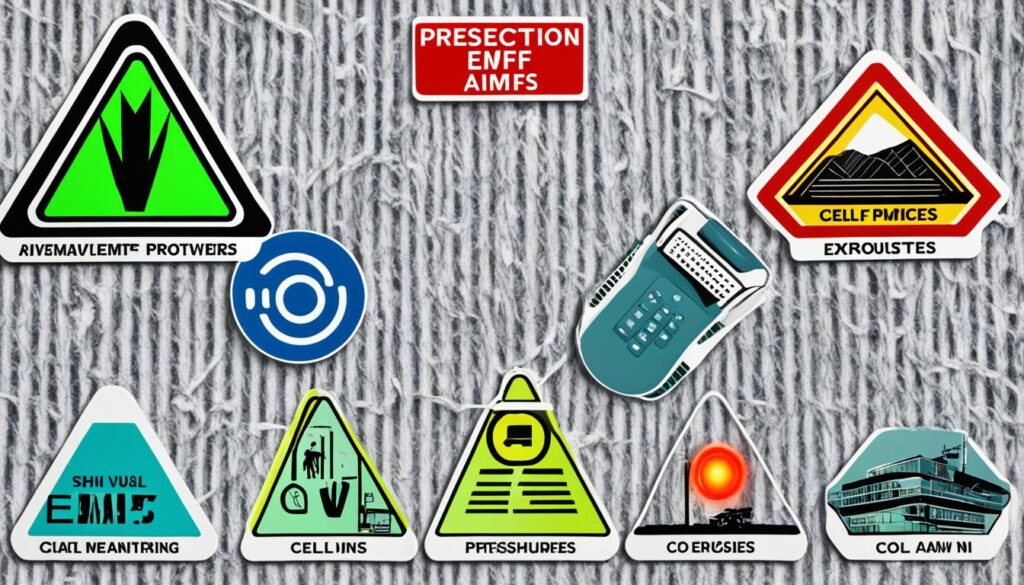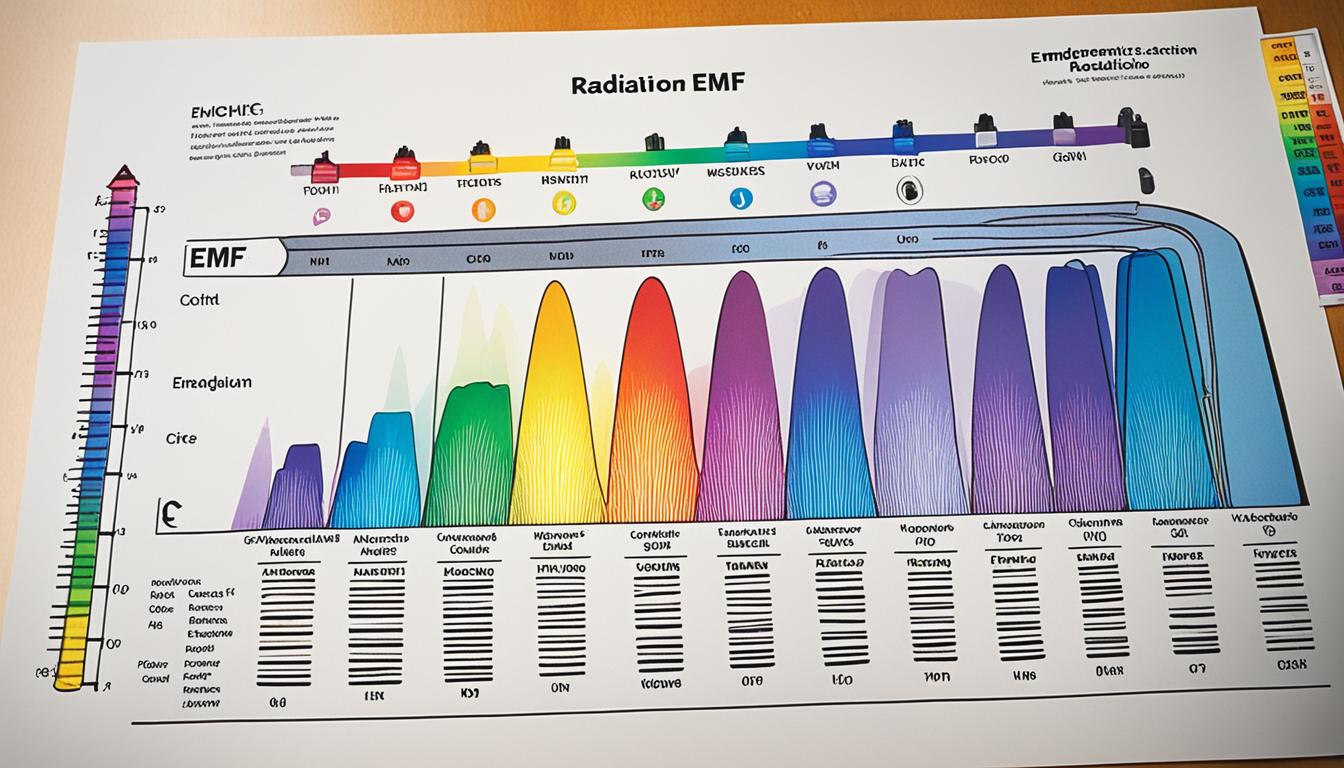Disclosure: This Post Contains Affiliate Links; We earn a commission on purchases.
Electric and magnetic fields play a significant role in our modern world. These fields describe the spatial distribution of a force acting upon electric charges and currents. Understanding the different types of electromagnetic fields (EMF) is essential for managing our exposure to them and ensuring our well-being.
In this comprehensive guide, we will explore the various types of EMF and their effects on human health. From static and low-frequency fields to high-frequency fields, we will delve into the intricacies of the electromagnetic spectrum and shed light on the importance of understanding EMF frequencies.
Key Takeaways:
- Electric and magnetic fields describe the spatial distribution of a force acting upon electric charges and currents.
- EMF can be categorized into static and low-frequency fields, and high-frequency fields.
- Low-frequency fields can produce electric fields and currents in the human body, while high-frequency fields can heat up biological tissue.
- It is essential to manage exposure to EMF to prevent potential health damage.
- Understanding the EMF spectrum and its effects on human health is crucial for a healthier living experience.
Categorizing Electromagnetic Fields
Electromagnetic fields can be categorized based on their frequencies or wavelengths. Understanding the different categories of electromagnetic fields is essential for comprehending their characteristics and potential effects. Frequencies are measured using Hertz (Hz), while wavelengths are measured in meters (m).
Static Electric and Magnetic Fields
Static electric and magnetic fields have a frequency of 0 Hz, meaning they do not vary over time. These fields can be generated naturally, such as the Earth’s magnetic field, or artificially, such as those produced by power lines or appliances.
Low-Frequency Electric and Magnetic Fields
Low-frequency electric and magnetic fields range from above 0 Hz to 100 kHz. These fields have longer wavelengths, ranging from over 300,000 kilometers to 3 kilometers. They are generated by various sources, including power lines, electrical devices, and some household appliances.
High-Frequency Electromagnetic Fields
High-frequency electromagnetic fields fall within the range of 100 kHz to 300 GHz. Their wavelengths are much shorter, ranging from 3 kilometers to 1 millimeter. This category includes frequencies used for radio waves, microwave ovens, WiFi, and cellular communication.
Frequencies Above 300 GHz
Frequencies above 300 GHz are generally referred to as “radiation.” These frequencies are used in applications such as satellite communication and radar systems. They have even shorter wavelengths, below 1 millimeter.
By categorizing electromagnetic fields based on their frequencies, it becomes easier to understand their properties and potential impact. The electromagnetic frequency spectrum provides a framework for analyzing and managing these fields.
Understanding the different categories of electromagnetic fields is crucial for ensuring the safety and appropriate use of technologies that emit these fields. By being aware of the various EMF spectrum bands, individuals can make informed decisions regarding their exposure to electromagnetic fields.
Understanding the Effects of Electromagnetic Fields
Electromagnetic fields have varying effects on biological organisms depending on their frequency and energy. It is important to understand the potential impact of these fields to effectively manage and limit exposure. While electromagnetic fields belong to the category of “non-ionizing radiation” and do not possess enough energy to cause direct damage to genetic material or be directly involved in the development of cancer, they can still have indirect effects on the human body.
Low-frequency electric and magnetic fields have the ability to produce electric fields and currents within the human body. On the other hand, high-frequency fields have the potential to heat up biological tissue. This distinction in effects emphasizes the need to stay informed and take proper precautions to ensure our well-being.
To prevent potential health damage, it is crucial to be aware of the specific exposure levels and to manage our interaction with electromagnetic fields accordingly. By understanding the potential risks and minimizing exposure, we can maintain a healthier living environment.
Practical Applications of Electromagnetic Waves
Electromagnetic waves have become an integral part of our daily lives, with a wide range of practical applications. From communication to medical advancements, these waves have revolutionized various industries. However, it is essential to prioritize EMF safety precautions when using devices that emit electromagnetic waves to minimize potential risks and ensure a safer environment.
Communication and Broadcasting
One of the most common uses of electromagnetic waves is in communication. With the advent of cell phones, radio broadcasting, and WiFi technology, these waves enable seamless connectivity and information exchange. Whether you’re making a phone call, streaming your favorite show, or browsing the internet, electromagnetic waves facilitate the transfer of data, ensuring that we stay connected in the digital age.

For many households, microwaves have become an indispensable kitchen appliance, relying on electromagnetic waves to heat food quickly and efficiently. The oscillating electric field generated by microwaves interacts with water molecules, causing thermal agitation and heating. This technology has simplified meal preparation, saving time and energy in the process.
Medical Imaging and Treatment
Electromagnetic waves also play a crucial role in the field of medicine. Medical imaging techniques such as X-rays, CT scans, and magnetic resonance imaging (MRI) utilize different frequencies of electromagnetic waves to capture detailed images of the human body. These imaging technologies help healthcare professionals diagnose and treat various medical conditions more accurately, leading to improved patient outcomes.
In addition to imaging, electromagnetic waves are also used in cancer treatment. Radiation therapy utilizes high-energy electromagnetic waves to target cancer cells and minimize damage to healthy tissue. This precise and targeted approach contributes to the effectiveness of cancer treatment, offering hope for patients and their families.
“The practical applications of electromagnetic waves have revolutionized communication, cooking, medical imaging, and cancer treatment. However, it is important to prioritize EMF safety precautions to ensure a healthier living experience for everyone.”
Safety Precautions for EMF Exposure
While electromagnetic waves offer numerous benefits, it is crucial to practice EMF safety precautions to minimize potential health risks. Here are some key steps to consider:
- Avoid prolonged and close proximity to electronic devices.
- Limit screen time and take regular breaks from devices that emit electromagnetic waves.
- Use hands-free options, such as speakerphone or headphones, during phone calls to reduce direct exposure to the head.
- Keep a safe distance from sources of electromagnetic waves, such as cell towers and high-voltage power lines.
- Use shielding devices, like EMF protective cases and clothing, to minimize exposure.
By following these safety precautions, individuals can navigate the world of electromagnetic waves responsibly and minimize potential health risks.
| Practical Application | Example |
|---|---|
| Communication | Cell phones, radio broadcasting, WiFi |
| Cooking and Heating | Microwave ovens |
| Medical Imaging and Treatment | X-rays, CT scans, MRI, radiation therapy |
Table: Practical Applications of Electromagnetic Waves
Radio Waves and Their Applications
Radio waves are a category of electromagnetic waves with frequencies greater than 0 Hz. They play a vital role in various applications, including communication, remote controls, and medical imaging.
One of the most well-known applications of radio waves is in the field of radio broadcasting. AM (Amplitude Modulation) and FM (Frequency Modulation) radio rely on the transmission of radio waves to carry information, allowing us to tune in to our favorite stations and enjoy music, news, and talk shows.
“Radio waves have revolutionized the way we connect and share information. From AM/FM radio to streaming platforms, radio waves continue to shape the world of communication.”
Radio waves are also used in remote controls, allowing us to wirelessly operate various devices in our homes, such as televisions, stereo systems, and even drones. The convenience and freedom of controlling devices from a distance wouldn’t be possible without the use of radio waves.
In the field of medical imaging, radio waves are utilized in magnetic resonance imaging (MRI) technology. MRI machines generate powerful magnetic fields that align the atoms in our bodies. By emitting radio frequency pulses and measuring their response, detailed images of our tissues and organs are produced, aiding in the diagnosis and monitoring of various medical conditions.
The wide range of applications for radio waves demonstrates their versatility and importance in our daily lives. From entertainment to healthcare, radio waves enable us to communicate, control devices, and gain insights into the human body.
Subranges of Radio Waves
Although radio waves encompass a broad range of frequencies, they are further divided into subranges. One such subset of radio waves is microwaves. Microwaves have higher frequencies compared to other radio waves and are commonly used in everyday devices such as cell phones, WiFi routers, and television signals.
Microwaves have revolutionized communication, allowing us to stay connected wirelessly through mobile networks and browse the internet via WiFi. They have also transformed the way we receive and transmit television signals, providing high-quality audio and video content to our homes.

The image above illustrates the electromagnetic spectrum, showcasing the different types of electromagnetic radiation, including radio waves. With their longer wavelengths and lower frequencies, radio waves occupy the leftmost section of the spectrum.
As we continue to advance technologically, the applications of radio waves will continue to evolve, enhancing our connectivity and improving various aspects of our lives.
Microwaves and Their Uses
Microwaves, a category of electromagnetic waves with higher frequencies compared to other radio waves, find extensive use in various applications. These applications include satellite communication, radar systems, and microwave ovens.
Satellite Communication: Microwaves play a crucial role in satellite communication, enabling the transmission of signals over long distances. The use of microwaves ensures reliable and efficient communication between satellites, allowing for seamless data transfer and communication services.
Radar Systems: Radar, short for “radio detection and ranging,” relies on microwave technology for its operation. Radar systems use microwaves to detect and track the position, speed, and distance of objects. This technology finds diverse applications in fields such as aviation, weather forecasting, and military operations.
Microwave Ovens: One of the most recognizable uses of microwaves is in microwave ovens. These devices utilize the oscillating electric field of microwaves to interact with water molecules present in food. This interaction causes thermal agitation and heating, resulting in the quick and convenient cooking or heating of food.
Did you know? The inventor of the microwave oven, Percy Spencer, discovered its cooking capabilities by accident when he noticed that a chocolate bar in his pocket melted when he stood near a magnetron, a device that produces microwaves.
Microwave ovens have revolutionized the way we cook, providing convenience and speed in the kitchen. With their ability to quickly heat and cook a wide range of dishes, microwave ovens have become an indispensable appliance in many households.
Microwave Oven Safety Tips
While microwave ovens offer convenience and efficiency, it’s important to use them safely to prevent accidents or damage. Here are some essential safety tips:
- Use microwave-safe containers and utensils to prevent potential hazards.
- Avoid overheating liquids in closed containers to prevent sudden eruptions upon opening.
- Always follow manufacturer’s instructions for cooking or reheating specific foods.
- Ensure proper ventilation to prevent the buildup of steam and heat.
- Never attempt to tamper with or repair a microwave oven without proper knowledge and expertise.
The Impact of Radar Technology
Radar technology, which relies on the use of microwaves, has had a profound impact on various sectors. Here are some notable applications:
| Application | Description |
|---|---|
| Aviation | Radar systems are crucial for air traffic control, ensuring safe navigation and guidance of aircraft. |
| Weather Forecasting | Weather radars help in monitoring and predicting weather patterns, aiding in emergency preparedness and disaster management. |
| Military Operations | Radar technology plays a vital role in military applications such as surveillance, target detection, and missile guidance systems. |
These are just a few examples of how microwaves have become an integral part of our technological advancements, enabling improved communication, efficient cooking, and enhanced safety across various industries.
Conclusion
Electromagnetic fields and waves play a significant role in our everyday lives, from enabling seamless communication to facilitating advanced medical imaging technologies. To safeguard our well-being, it is essential to have a comprehensive understanding of the different types of electromagnetic fields and their impact on human health.
By familiarizing ourselves with the EMF Spectrum Guide and being mindful of the EMF exposure levels guide, we can effectively manage and limit our exposure to electromagnetic fields. This involves following safety precautions and implementing measures to control our electromagnetic environment.
To further aid us in monitoring and analyzing the electromagnetic spectrum, the use of an EMF radiation spectrum analyzer can be beneficial. This tool enables us to assess the presence and intensity of electromagnetic fields, allowing for informed decision-making regarding our exposure levels.
Ultimately, by staying informed about the EMF Spectrum Guide, following safety guidelines, and utilizing resources such as an EMF radiation spectrum analyzer, we can successfully navigate our electromagnetic environment and prioritize our well-being for a healthier living experience.
Source Links
- https://www.rd.usda.gov/sites/default/files/UWP_WI64-Dairyland_CapXHRLC_FEIS-AppH.pdf
- https://openpress.usask.ca/physics155/chapter/13-5-the-electromagnetic-spectrum/
- https://www.bfs.de/EN/topics/emf/introduction/introduction_node.html

Subscribe to Our Newsletter










